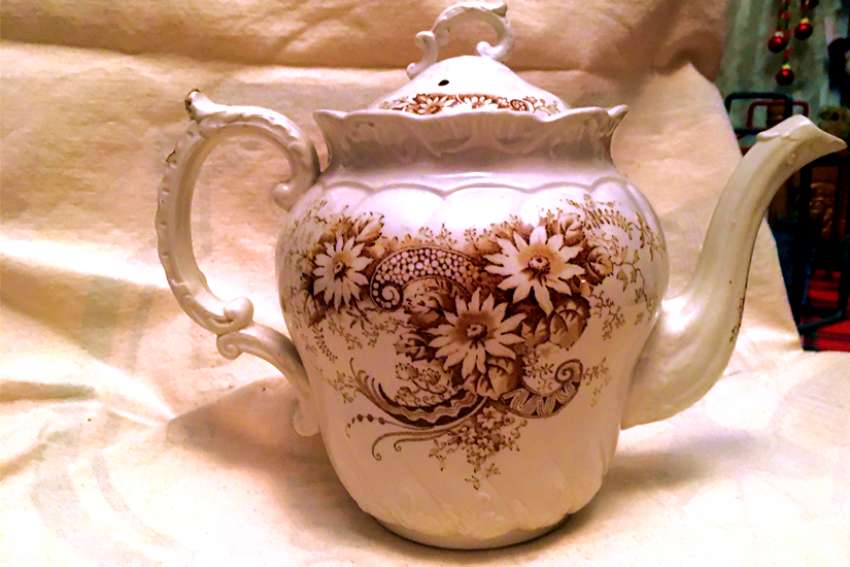The old teapot is steeped in history, fortitude and faith.
If it could talk, whistle or chatter, what a tale this 200-year-old china cauldron might tell.
Its antiquated story begins in the highlands of Scotland, in the Lochaber area, where it was acquired by a branch of the Campbell clan. Of that family, Angus Campbell left the only home he had ever known in 1838 to set forth on a perilous month-long transatlantic journey to the new world, landing at Cape Breton Island at the northwestern tip of what would eventually become the province of Nova Scotia.
What kind of courage, desperation or sense of adventure might lead a clannish Scot to pack up his teapot and depart for a land about which he had probably only heard vague snippets of description from other Gaelic-speaking highlanders?
In his book Highland Settler, originally published in 1953, Scottish-born author Charles Dunn portrays the highlander’s physical environment in Scotland as rugged, often steeply sloped terrain close to a river or sea coast. The land was not easily accessible which made its inhabitants fiercely independent and isolated in small groups.
The small communities seldom intermingled and suspicion and rivalry often led to feuds and brutal fights among clans.
The highlands lacked sufficient arable land to support a farming population. When new landlords replaced traditional highland chieftains, the price of land rose so sharply that small tenant farmers were left with little hope of meeting annual rents. In some areas, landlords could squeeze more revenue from their property by raising sheep to meet a burgeoning wool market rather than renting it out.
“Whether the highlander emigrated from economic necessity or from personal choice, he certainly could not have relished parting from the homeland which he loved,” wrote Dunn. “Yet even the most wretched emigrant, as he embarked on the voyage, must have nourished some ray of hope in the possibilities of the new and unexploited land of the new world. …
“Those whose only home had been a one-roomed stone cottage and whose only farm had been a rented patch of stony ground dreamed of broad, fertile fields; those who had been subject to the caprice of a heartless landlord looked forward to land of their own; those who lived in fear of political enemies yearned for personal liberty; and those who had suffered persecution for their religious faith thirsted for freedom of worship.”
Against this backdrop the family teapot took its place among a mass North American emigration from the highlands and islands of western Scotland. Upon arrival in Cape Breton and other parts of northern Nova Scotia, Angus Campbell and his fellow immigrants must surely have wondered if they had been sold a bill of goods.
“Rough, untamed forest land was all that a place like Cape Breton might seem to offer,” Dunn wrote. The bitter cold of winter would break only long enough for a significant dump of snow, both elements that the highland Scot was unaccustomed to in his former homeland.
The reward for surviving the Atlantic voyage and exposure to smallpox, dysentery and measles was seemingly endless, back-breaking work. The new arrivals lived in rudimentary shelters and ate whatever food that they could grow or procure from neighbour settlers.
Despite some overwhelming odds, Angus Campbell and a good number of his fellow immigrants survived. Some even thrived. Angus became the North American forefather of Campbells that settled in a remote corner of Cape Breton and then branched out to other parts of Nova Scotia, Ontario, Alberta, British Columbia and several American states.
A succession of Angus Campbells descended from that first transatlantic traveller, a string that includes my grandfather, my father and now, my son. That particular Campbell strain could not have flourished without the courage of a single person to leave everything familiar behind, to put one faltering footstep in front of another and turn it into a great leap of faith.
Along with the teapot, Angus Campbell brought with him an abiding Catholic faith, most likely a worn set of prayer beads and an ability to readily recite the rosary and other prayers in his native Gaelic. In the new world, Angus and fellow immigrants helped form a robust Catholic community and church to support the fledgling settlement.
From the first Campbell of my clan to cross the ocean, I gratefully inherited an amazing country to call home and a steadfast Catholic faith. I’ve been designated as the family caretaker of the transcontinental teapot, but the ancestral fortitude of the teapot’s first steward remains beyond reach.
(Campbell is a reporter at the Halifax Chronicle Herald.)


